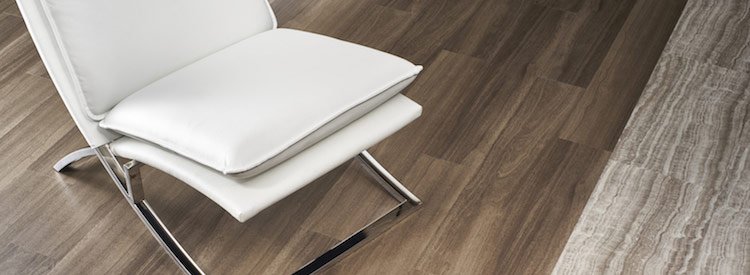Luxury Vinyl vs. Laminate Flooring

Laminate and vinyl flooring are, in many minds, one in the same. And while that may have been somewhat true 20 years ago, the differences of two decades have divided the flooring solutions into distinct camps—especially with the introduction of LVT.
To best illustrate the comparable characteristics of premium vinyl vs. laminate flooring, let’s break flooring down into four quantifiable qualities: Look & Style, Durability & Stability, Applications, and Cost.
Look & Style
When it comes to design integrity, the vinyl vs. laminate comparison is pretty even. Because both are made using a 3D printing technology, each can replicate the look and style of natural materials such as wood and stone, but at the fraction of the cost. Limitlessly customizable and designable, both vinyl and laminate allow the versatility needed to complete any interior design project.
Laminate Flooring
- Laminate can replicate the look and style of natural materials
- A fraction of the cost of other materials
- Limitlessly customizable and designable
Luxury Vinyl Tile
- Luxury vinyl flooring can replicate the look and style of natural materials
- A fraction of the cost of other materials
- Limitlessly customizable and designable
Durability & Stability
Before discussing the durability and stability of premium vinyl vs. laminate, we should define the terms, as they seem similar:
- Durability: Hardness of the flooring—especially its topmost wear layer. The more durable a flooring solution is, the more use it can take.
- Stability: Governed by the thickness of the whole and/or makeup of layers and quality of materials. Stable flooring material holds its shape and size against moisture and/or climate changes.
Both vinyl and laminate are constructed in similar ways, generally with a wear layer, photographic image and a backing system. The composition, however, varies.
Laminate is typically made from HDF or high-density fiberboard, which is made up of recycled hardwood. Laminate is not waterproof so it is not recommended to install this product in high-moisture or humid areas or places that often have spills like in supermarkets or in restaurants. Laminate is best to install in climate-controlled areas.
Vinyl, however, is a much different story. Parterre vinyl in particular is a hard, closed-cell vinyl allowing for the product to be more water resistant and ideal for higher-moisture areas. A sealant is not required for vinyl, but is recommended for high-moisture areas for an added layer of protection.
Laminate is a hard product, but tends to also be hollow. It is important that the subfloor underneath is smooth and even. Vinyl is ideal for heavy trafficked areas due to its ability to expand and contract. And, both are very easy to clean. Read more about LVT for high-traffic areas.
Laminate Flooring
- Laminate is typically made from HDF or high-density fiberboard (made up of recycled hardwood)
- Not waterproof
Luxury Vinyl Tile
- Luxury vinyl flooring is more water resistant and ideal for higher-moisture areas
- Does not require a sealant
Applications
Based on this review in Durability & Stability, the application of laminate does not quite compare to the multi-faceted, cross-purpose functionality of premium vinyl flooring. Due to its susceptibility to moisture, climate and physical damage (and lack of ways to repair said damage), laminate is inferior to vinyl in various commercial flooring installations, especially in areas susceptible to high moisture and humidity.
All industries can benefit from vinyl flooring. Laminate on the other hand is not ideal for industries with areas of high moisture and humidity, and are prone to spills and exposure to water.
Laminate Flooring
- Not ideal for industries with areas of high moisture and humidity, and are prone to spills and exposure to water
Luxury Vinyl Tile
- Multi-faceted, cross-purpose functionality
Cost
The premium vinyl vs. laminate gap finally closes. At $.50—$5 per square foot, laminate matches and even (albeit at the lower end) comes in under premium vinyl, which may be priced from $2—$5 per square foot for commercial products. With such similar prices and dissimilar qualities, the choice seems like a no brainer. Premium vinyl wins out when factoring in the flexibility it allows in terms of design and application.
Laminate Flooring
- Depending on the size, color and quality of the tiles, laminate falls within and far above the price of LVT
Luxury Vinyl Tile
- LVT is not only less expensive than laminate, it offers a much higher value
Look & Style
Cost
Durability & Stability
Applications
If you found this comparison of premium vinyl vs. laminate flooring helpful, check out our blog. We at Parterre are the leaders in modern, high-quality premium vinyl flooring. We would love to work with you on your next project.
SaveSave
Parterre Flooring
Read MorePolished Concrete vs. Vinyl Flooring
Polished Concrete vs. Vinyl Flooring Polished concrete vs. vinyl flooring. It’s not an easy decision, considering both provide an excellent solution for commercial flooring. The look of concrete floors has been a growing trend for commercial interiors.
Chevron and Herringbone
Break the Pattern of Commercial Flooring You can add more flair to your commercial flooring by breaking from the look of traditional straight-line, square, and diagonal patterns. Eye-catching looks like chevron and herringbone will dot the designer landscape in 2024.